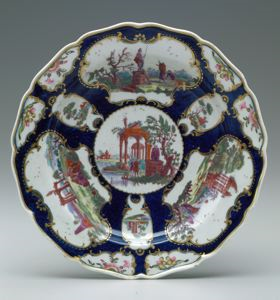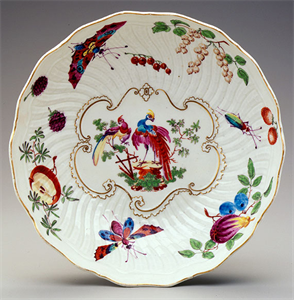
Worcester Porcelain Factory
English, born established 1751
Robert Hancock
English, (active about 1731–1817)
This plate was decorated through the process of transfer printing. Transfer printing, one of the few original English contributions to ceramic art in the eighteenth century, was an important decorative technique at Worcester, and the company excelled in both its quantity and quality from its first appearance in 1753 through the 1770s.
Transfer printing involved transferring an image from an engraved or etched copper plate to dampened paper, which in turn was then applied ink side down onto the ceramic surface. This process was more cost efficient and direct than hand-painting, and produced wares that were regarded as equal in quality to hand-painted designs. Although great skill was required to etch the plate, the design could be used repeatedly for quick decoration by relatively novice artisans. At Worcester, transfer printing was done in both underglaze cobalt blue and in overglaze enamel colors. Black, called "jet" in the eighteenth century, was the most commonly used color for overglaze transfer printing, but examples are also found in sepia and lilac. Transfer printing and hand painting were sometimes used in combination as with this plate: the artist would fill in the linear boundaries of the transfer print with colored enamels and gilding. The designs on this plate have been attributed to Robert Hancock (about 1730-1817), an engraver who arrived at the company in 1756, and undoubtedly was largely responsible for much of the success of Worcester's transfer-printed wares.
English, born established 1751
Robert Hancock
English, (active about 1731–1817)
Plate
about 1768
Object Type:
Ceramic
Creation Place:
Northern Europe, English, Worcestershire
Dimensions:
1 3/8 in. x Diam: 9 in. (3.49 cm x 22.86 cm)
Medium and Support:
Porcelain
Accession Number:
1997.0001.0001
Credit Line:
Gift of Mr. and Mrs. James Lucien Loeb
Currently On View
This plate was decorated through the process of transfer printing. Transfer printing, one of the few original English contributions to ceramic art in the eighteenth century, was an important decorative technique at Worcester, and the company excelled in both its quantity and quality from its first appearance in 1753 through the 1770s.
Transfer printing involved transferring an image from an engraved or etched copper plate to dampened paper, which in turn was then applied ink side down onto the ceramic surface. This process was more cost efficient and direct than hand-painting, and produced wares that were regarded as equal in quality to hand-painted designs. Although great skill was required to etch the plate, the design could be used repeatedly for quick decoration by relatively novice artisans. At Worcester, transfer printing was done in both underglaze cobalt blue and in overglaze enamel colors. Black, called "jet" in the eighteenth century, was the most commonly used color for overglaze transfer printing, but examples are also found in sepia and lilac. Transfer printing and hand painting were sometimes used in combination as with this plate: the artist would fill in the linear boundaries of the transfer print with colored enamels and gilding. The designs on this plate have been attributed to Robert Hancock (about 1730-1817), an engraver who arrived at the company in 1756, and undoubtedly was largely responsible for much of the success of Worcester's transfer-printed wares.
Keywords
Click a term to view the records with the same keyword
Portfolio List
Click a portfolio name to view all the objects in that portfolio
This object is a member of the following portfolios:
Your current search criteria is: Keyword is "BY" and [Object]Display Artist is "Worcester Porcelain Factory".

 by Country (2)
by Country (2)
